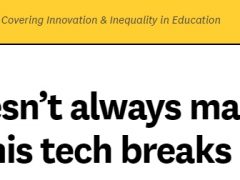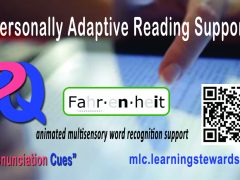Using today’s inexpensive digital technology we can easily add another ‘learner’s layer’ to English orthography and completely reimagine literacy learning through the lens of what ‘hyper-orthography’ makes possible.


Using today’s inexpensive digital technology we can easily add another ‘learner’s layer’ to English orthography and completely reimagine literacy learning through the lens of what ‘hyper-orthography’ makes possible.

Learning Stewards is delighted to announce our new partnership with the Story Preservation Initiative. The Story Preservation Initiative (SPI) records the personal narratives of high achievers in the arts, sciences, and humanities. (Think artists, astronauts, scientists, engineers, environmentalists … and more). They couple their audio recordings and transcripts with project-based lesson plans for use in […]

Click on any word on this page to experience it yourself (keep clicking until the box turns green). Imagine an entirely new kind of instruction and support system for beginning and struggling readers. Rather than having to remember and apply abstractly ambiguous instructions, learners simply touch any word they stutter on and immediately receive decoding, […]
THE 3 STEPS OF THE MAGIC LADDER #1 – Click on ANY word that doesn’t quickly pop to mind. Look and listen to ‘cues’. #2 – Try to read the word again. If still can’t, click word again. Look and listen to ‘cues’. #3 – Repeat steps 1 and 2 until word is recognized. Clicking […]
This video demonstrates the Magic Ladder’s PQ App (A FREE Chrome Browser extension) that works on on millions of common education and reference resource sites (including #ReadWorks, #CommonLit, #Wikipedia, #ProjectGutenberg). The PQ App works on any word and every word of most websites and provides instantaneous word recognition support. It provides personally adaptive scaffolding for […]
Reading Instruction! (Note: This article was published in the April 2018 print and online versions of Language Magazine) More accurately stated, the number one cause of low literacy in America is the archaic mental models that constrain the ways we conceive of, design, and deliver reading instruction. Over half of all the K-12 students in […]
According to NAAL data, reading proficiency remains a significant bottleneck to social and economic progress for tens of millions of U.S. adults. Adults struggling with literacy (in their native language) are not only struggling with the inherent difficulties involved in literacy learning, they are struggling with what they learned in the past that is sabotaging […]
NO MORE INSTRUCTIONAL CONFUSION, GUESSING, OR MIND-SHAME! Learning to Read is 1-2-3 (and free!): 1) Click on any word. 2) Try to read word in Pop-up. Can’t? Click word in Pop-up. 3) Repeat Step 2 as needed. Click on any word below and follow the steps: 1,2,3. to ice eye have know meow wolf pour fury idea heart acres […]

Note: See Demo at bottom of page Convergence Point 1 – Decades of social and economic research, beginning with the Coleman Report and since including Heckman, (Nobel Prize winner) Rolnick (Ex. V.P. of the FED), Hanushek (Hoover Institute) and many others, and decades of developmental neuroscience research, most notably as compiled by Harvard’s Jack Shonkoff, have converged and coalesced into […]
Kids in the future will not be ‘taught’ to read. Every interaction with every word on every device will support them learning to read on their own. We only sense now. We only feel now. We only think now. We only learn now. We are naturally ‘wired’ to learn from what is happening on the living edge of now. Humans learn best […]
